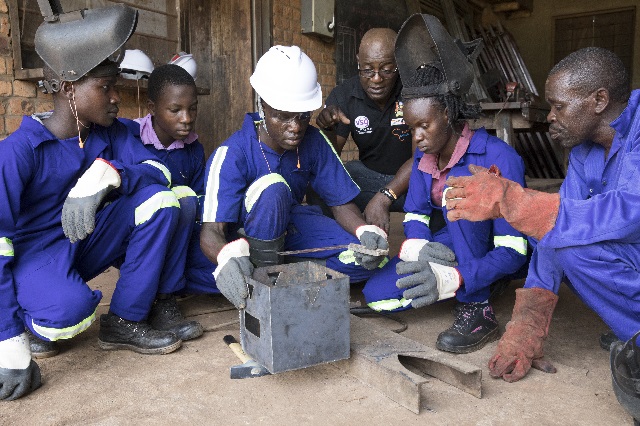
TVET provides practical, hands-on training in various industries and prepares students for employment or entrepreneurship
Kampala, Uganda | THE INDEPENDENT | Several parents are working up their phones as they struggle to secure placements for their children in secondary schools following the release of Primary Leaving Examination results on Friday last week. Many parents opt to search for vacancies for their children even before the national selection exercise owing to the high competition for placement in certain schools.
However, experts advise parents as they scramble for secondary school placements, they should also consider the Technical, Vocational Education, and Training (TVET) path. Gabriel Ocaka, the chairperson of TVET institution principals, says the Technical and Vocational Education path is not just a backup option for those who have failed PLE or the poor but an academic path with numerous benefits for all types of learners.
“Both male and female, bright and average students can gain entry into TVET institutions, such as community polytechnics, where they can acquire valuable, lifelong skills. TVET provides practical, hands-on training in various industries and prepares students for employment or entrepreneurship,” notes Ocaka.
Community Polytechnics, Technical Schools, and Farm Schools admit learners who have completed primary school and provide them with three-year training programs equivalent to the Ordinary Level certificates awarded by the Uganda National Examination Board (UNEB) to their senior four counterparts.
At this level, students have an opportunity to choose from 16 programs, including Welding and Metal Fabrication, Motor Vehicle Mechanics, Block Laying and Concrete Practice, Electrical Installation Practice, Plumbing, and Pipe Fitting, business studies (storekeeping, accounting, and secretarial studies), Carpentry and Joinery among others.
Ocaka notes that parents have been avoiding TVET education due to societal biases that favour traditional academic paths and a lack of awareness about the benefits of TVET. He explains that many parents may not understand the value of practical, hands-on training and may view it as inferior to traditional academic programs.
The principal adds that some parents have been declining to enrol their children in technical institutions citing their young age. He, however, argues that this is not a valid reason as completing the three-year program is not the end of a student’s learning journey. “There is a full learning path ahead, and students can continue their education for as long as their parents wish,” the principal asserts.
He adds that; “After completing three years at a polytechnic, a learner can continue to a technical institution, similar to those who transition from O-Level to A-Level in traditional secondary schools. The advantage of the TVET path is that the learner will already have acquired skills, even if they choose not to return to school. On the other hand, their counterparts in senior four will have nothing to show for it.”
Eddy Tureyatemba, Assistant Commissioner of TVET at the Education Ministry, states that the government has decided to decentralize the selection process for those seeking government sponsorship for TVET education. Tureyatemba adds that admission forms can be picked up at district headquarters or nearby technical institutions to fill in the forms.
The national TVET selection for primary school leavers will take place from February 17th to 19th this year. Learners from the central region will be selected at Nakawa Technical Institute, those from the eastern region at St. Kizito Institution in Soroti, the western region at Nyamitanga Institute, and those from the north at Youth Development Centre in Omoro District.
Available information indicates that the government will sponsor 60 students per institution this year, who will be distributed among 44 government-owned institutions. The Universal TVET education program has not yet been implemented.
However, Ocaka says that in addition to government sponsorship, there are both private institutions and government TVET institutions that accept private students. He mentions that the cost of attending these institutions is relatively low, with fees ranging from 500,000 Shillings to 800,000 Shillings including hostel fees.
He further states that the tools and equipment required for the courses are not too demanding, and they purely belong to the learner. This means that a learner can use the course to earn income during the course or after completing the program.
He further points out that the flexibility of the program allows learners to learn at their own pace, even if they do not have the financial means to support their education.
“They can complete a module; covered in a period of three months (equivalent to a school term), go home and practice, then return to continue their education when they have the means to do so. This provides an opportunity for those who may not have financial support to still get the education and skills they need,” Ocaka adds.
Sam Byagweri, the principal of Bushenyi Technical College attests that a learner can climb through the ladder of learning under the TVET path to move to higher qualifications, including technologist degrees and post-graduate degrees.
Byagweri notes that taking the TVET path can lead to higher qualifications and a successful career, as he himself has done so. He dropped out of school after senior four and sat at home for two years, but still managed to climb the ladder and become a civil engineer.
“When I dropped out of school, I struggled to find the fees to return. I had no skills and knew nothing. I eventually found work on a tea estate and saved enough money to sponsor myself in a technical institution. I have friends who went straight to these institutions after primary and never struggled as I did. Today, some have PhDs, and others are experts in their fields.” Says Byagweri.
To date, Byagweri says he still aspires to continue learning in his field, demonstrating the potential of TVET education.
*****
URN
 The Independent Uganda: You get the Truth we Pay the Price
The Independent Uganda: You get the Truth we Pay the Price



